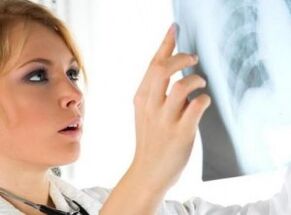Today, osteochondrosis today is considered the “century disease”, because most of the time people are suffered by people whose work does not require increased motor activity.
In most cases, changes in cartilage and bone tissue are observed in people of active age - up to 40 years.
The disease can affect different parts of the spine, and the second most prevalent is osteochondrosis in the cervical region.
What is it?
Osteochondrosis are dystrophic disorders of joint cartilage and adjacent bone tissue.
Previously, the term extended to a large group of bone-articial diseases, but is now used only with a degenerative spine disease.

Compared to other departments of the spine, the cervical region is the most mobile and has many nerve and vascular formations.The structure of the vertebrae is small, as well as being surrounded by a very weak muscle corset.
This anatomical structure predisposes to the development of osteochondrosis, the severity of clinical manifestations depends on the nature of changes in intervertebral discs and the degree of destruction.
The causes of disease development
The main and most common cause of cervical spine osteochondrosis is a sedentary lifestyle.
Due to the lack of physical effort with a sedentary lifestyle and sitting:
- Metabolic processes are violated;
- The level of salts in the bloodstream and the lymphatic liquid increases;
- In the cervical region, the kidneys and liver of the spine, the salts are placed.
Damage to cervical vertebrae are mainly determined by the lack of nutrients in intervertebral discs.Therefore, the main reasons for cervical osteochondrosis also include inadequate and unbalanced nutrition.
Risk factors
There are many risk factors for cervical osteochondrosis.

The most common factors are:
- heredity;
- Age -related changes;
- cervical spine lesions;
- hypothermia;
- hormonal disorders that lead to metabolic disorders;
- Some autoimmune diseases that lead to damage to cartilage tissue (systemic lupus erythematosus, rheumatism).
What is dangerous
Not only the spinal cord and nerve roots pass through the cervical spine, but also the vertebral artery, responsible for providing blood from the back of the brain, an oblong and cerebellum brain.
Therefore, with cervical osteochondrosis, this artery is squeezed and, as a result, a violation of brain circulation.
In particularly advanced cases, squeeze the artery and adjacent blood vessels and nerve plexuses can lead to consequences such as:
- Violation of coordination;
- decreased hearing and vision;
- Stroke.
If you do not cure the disease at the early stage, this can lead to complications: intervertebral disc or intervertebral hernia protrusion.
The degree of development of the disease
Cervical osteochondrosis, such as osteochondrosis of another column, develops in stages.There are 3 stages of disease development.
1 degree
It is characterized by the beginning of the destruction of the intervertebral discs.
Cracks are formed in the fibrous ring, the strength and elasticity of the disc are formed, their height decreases, because the nerve roots are squeezed.
A painful pain characteristic appears.Sometimes, in 1 stage (pre -clinical), this pain may be absent, and osteochondrosis proceeds with moderate neck discomfort.
2 degree
If 1st degree osteochondrosis was not treated or treatment has not been effective, there is a chronic condition, which is the second degree of osteochondrosis.
The pain becomes constant, the destruction and seal of the intervertebral disc continues and lead to small dislocation of the cervical vertebrae.
With cervical osteochondrosis, a falling head syndrome can develop at this stage.This syndrome is characterized by intense pain and a person is forced to support his head in a fixed state to reduce pain.
3 degrees
The third degree cervical osteochondrosis is accompanied by the following signs:
- headaches;
- nausea;
- dizziness;
- "Cervical Bastards";
- Violation of the sensitivity of the upper ends.
The fibrous ring is almost destroyed, which leads to complications of osteochondrosis - intervertebral disk protrusion or intervertebral hernia.
In 3 stages of osteochondrosis, the intensity of the pain can decrease, since the cartilaginous tissue affected on the intervertebral disc simply does not exist, which means there is no source of pain, but the pinch of nerve roots remains, so that the pain does not completely come out.
Characteristics and Symptoms
There are many signs of manifestation of this disease.And they depend on which vertebrae are damaged by this disease.

The characteristic syndromes of cervical osteochondrosis are:
- Column syndrome;
- Vertebral Artery Syndrome;
- Cervical migraine syndrome;
- Hypertension syndrome.
All of these syndromes are accompanied first and foremost by different types of pain.
If we consider vertebral artery syndrome, the headache manifests itself at the early stage of disease development.
At the same time, pain attacks can be accompanied by:
- dizziness;
- Shake march;
- Visual symptoms (the appearance of the fog before the eyes, a decrease in visual acuity, etc.).fainted (with clear head movements).
With hypertension syndrome, increased intracranial pressure is determined.
A headache is more exploded, can be accompanied by nausea and vomiting.With the exacerbation of cervical osteochondrosis, an increase in temperature and an RESH increase can be observed.
By compressing the roots of the spine (“roying syndrome”), the following neurological symptoms may appear:
- Pronounced pain in the neck (cervicalgia);
- Pain in the neck, spreading in the forearm and bone of the shoulder (cervicobrachialgia);
- Hand pain;
- sensations of crispness or cod in the neck when turning the head;
- The pain “giving” the ear, which occurs only after a long stay in an uncomfortable position or in a clear movement;
- pain or feeling of a coma in the throat, breathing disorders;
- Numbness of the hands and tongue;
- a feeling of swelling of the tongue;
- Pronounced weakness;
- violation of hearing and vision;
- noise in the ears;
- General deterioration in well -estar.
With “cervical migraine” syndrome, the sympathetic nodes are irritated, which leads to impaired reactivity of brain vessels and circulatory disorders.

As a result, hypertension can develop, usually accompanied by:
- ears with congestion;
- tachycardia;
- noise in the head;
- Calling in the ears.
By compressing the blood supply in the spinal cord of the arteries, a vertebral column course may occur.
Interruption of blood circulation in the brain with osteochondrosis can lead to:
- oxygen insufficiency of brain cells;
- mental disorders (state of depression, panic attacks);
- The appearance of episode signs, such as loss of consciousness and short -term tension - is often confused with signs of epilepsy.
Such a sign of cervical osteochondrosis as changes and heart rhythm, such as extrystol or arrhythmia, is very common.
Such signs are very common among drivers and office workers.
Due to the sedentary lifestyle in the intervertebral dishes of the cervical and thoracic spine, changes occur, which leads to heart disorders.
In most cases, until osteochondrosis is healed, it will be practically impossible to get rid of the disorders at the heart rhythm.
Swelling under the eyes may also indicate osteochondrosis of the cervical region.
Most of the time, they depend on the position of the head during night sleep, spend the day and are combined with headaches, dizziness, head weight, etc.
Vegeta -vascular dystonia is another of the common diseases that occur in this disease.
It is a consequence of tightening the vascular arteries that pass on the sides of the spine of the spine.
Diagnostic methods
A preliminary diagnosis is established by a neurologist during the initial examination of the patient.More recently, the doctor had to diagnose, having only performed an external examination of the patient and sending it to the X -ray.
Unfortunately, however, at the X -root, it is impossible to see a complete image of the disease development.

Currently, exams such as computed tomography and magnetic resonance imaging are available, with which you can completely evaluate which stage of development is the disease.
After the diagnosis, the patient goes to the specialized doctor in this area.
Which doctor treats?
A narrow -oriented expert is involved in treatment - a vertebrologist or a vertebroneurist.
Treatment of cervical osteochondrosis
The basis for the treatment of cervical osteochondrosis is the severity of the main clinical symptoms.
In the cervical region, symptoms are mainly associated with the tightening of blood vessels and nerve endings;Therefore, during treatment, edema is mainly relieved and blood circulation is restored.
There are many treatment methods used in the treatment of cervical spine osteochondrosis.
The most effective treatment is a complex, which is a combination of various conservative treatment methods.
Complex treatment of cervical osteochondrosis may include the following traditional and non -traditional methods: drug treatment, massage, acupressure, manual therapy, physiotherapy, acupuncture, homeopathy, folkloric medicines, etc.
The stages of osteochondrosis treatment are the same for all locations of this disease:
- First, you need to remove pain syndrome.
- Then the edema will be removed.
- At this stage, it is necessary to normalize blood circulation.
- Strengthening muscle corset.
- Improving nutrition and tissue regeneration.
Only the team of good experts, which includes a neurologist, physiotherapist, masseuse, surgeon, vertebroneurologist, can choose the most appropriate therapy.
Like any disease, treat cervical region osteochondrosis at the early stage of the occurrence.If you do not start the process at this stage you can get a complete cure of osteochondrosis.
Unfortunately, 2 and 3 stages of cervical osteochondrosis are accompanied by the complete or partial destruction of intervertebral discs;Therefore, these stages are characterized by a very long recovery process.
First aid
How to relieve pain with exacerbation?
With severe pain, you need to take anesthesia from a home medicine cabinet.You can also stick a pepper patch with pain.
When edema appears, diuretics can be taken.Rubbing the neck area with painkillers can help.
Medical Physical Education in exacerbations is against -Indicated, as well as warming, as these influences can cause serious complications.
After removing acute pain, you should urgently consult your doctor for consultation.
Medicine treatment
The medications usually start with injections (exacerbation) and then change to tablets and candles in combination with the local use of ointments and gels.
Anesthesia in drug treatment is performed using anti -inflammatory drugs steroids.
Be sure to prescribe drugs that restore brain circulation.
With pathological muscle tension, muscle relaxants, such as midocom, can be prescribed.For more effective treatment, vitamins are performed in the therapeutic dose and tracking elements.
In cases of intervertebral hernia, surgical intervention is not rarely recommended and the assistant doctor may offer an operation.
Massage and Self -Massage
This method combines well with physical therapy and physical therapy.You can take a massage course at any medical institution and resort to private practices.
Massage is required for cervical osteochondrosis to strengthen muscles and relieve tension in the neck.
The task of the massage therapist is to remove harmful products from metabolism, as well as relieve the spasm of the pathology zone, increasing the output and flow of blood in the pain zone.
The main techniques used by experts during neck massage are:
- caressing;
- squeezing;
- crushing;
- vibration;
- knead.
The self -massage technique can be performed using the following techniques:
- caress (movements should be soft, without much effort forming folds);
- knead (deep effect on muscles, capture in fold, pressure and push -ups);
- Vibration (oscillatory effects by shading, tremors, tapting).
Self -Massage should always be completed by stroking.During vibration, you can use a massager.
Supreme massage
Surplus massage relieves headache with cervical osteochondrosis exacerbation, it helps with pressure spikes, normalizing it.
Acupressive scheme:
- The impact on the feng fu point, located under the occipital hill for 1 minute.
- The impact on the Feng-Chi point, located at the width of two fingers of the special processes of the skull.
- Exhibition for 1-1.5 minutes at Point I-Men (is located at a distance of three fingers at the fen-Fu width).
- The sedative exposure is 1-1.5 minutes at the cavilha point (7th cervical vertebra).
After acupressure, it is necessary to lie for several minutes as a small dizziness may occur.
Manual therapy
Manual therapy helps deal with acute and chronic pain, also increases the volume of movements and improves posture well.
The main techniques of manual therapy for cervical spine osteochondrosis:
- Relaxing and segmental massage.It is used to heat the muscles and relieve tension.
- Mobilization.Impacts intended to restore joint functions.The tensile method.
- Manipulation.An accentuated impulse for the patient's pathological zones.The procedure is accompanied by a characteristic crisis (the return of the joint to a normal position).
Manual therapy specialized in practitioners must have these techniques perfectly.Otherwise, any error can lead to injuries.
Acupuncture
Acupuncture contributes to the release of cortisol in the blood.This hormone has a pronounced anti -inflammatory effect.

Acupuncture is performed by exposure to points near the inner edge of the scapula.The needles are introduced at a depth of 1 to 2 cm and are left for exposure at 10 to 30 minutes.
Homeopathy
Drug treatment carries many side adverse consequences, so homeopathy can become a decent substitute for treatment without undesirable consequences.
With cervical osteochondrosis with pronounced hypertension (expressed by pain in the back of the head), strontium carbonate is used.
Assign at 3, 6, 12 and 30 reproduction.
Nutrition Characteristics
Foods should be saturated with calcium and magnesium.
These trace elements are located in fish and seafood, nuts, vegetables and dairy products.
Frequently, neck osteochondrosis can be accompanied by atherosclerosis.In this case, a difficult diet is recommended.
The diet is prescribed for 3-4 months.It is necessary to limit the consumption of all products that contain cholesterol.This includes animal fats, fatty varieties of meat, fatty dairy products, etc.In addition, salt, sugar and flour products should be limited or excluded.
It is recommended to abandon bad habits (smoking, alcohol, etc.).
Cervical osteochondrosis and alcohol are interconnected.The fact is that by falling into the blood, alcohol destroys cells, thus aggravating the blood circulation already disturbed to osteochondrosis.
Therefore, it must be limited to the minimum and during the period of exacerbation completely abandon the use of alcohol.
Disease prevention
To avoid cervical osteochondrosis, it is recommended to follow the following rules:
- The dream must be in a solid mattress and a low pillow: the neck flexion angle should not exceed 15 degrees;
- Take a hot shower every day for at least 10 minutes;
- Visit a sauna and a bath as soon as possible: warmly helps to remove cramps from the neck;
- Let us go ourselves aerobic loads and regular tours at a low rhythm;
- get involved in swimming;
- After 25 years, avoid the shock load in the spine (jumping, running);
- When sitting, be sure to make five breaks every hour;
- Regular yoga classes may prevent any manifestations of cervical osteochondrosis;
- Refuse to visit the academy, as bodybuilding classes may cause the cervical disc protrusion to occur;
- Exercise as a prevention for neck osteochondrosis helps strengthen cervical muscles, alleviate tension.
Frequently Asked Questions
What to do during pregnancy and how to treat it?
It is often during pregnancy that the first symptoms of cervical osteochondrosis occur.
This is due to the change in the hormonal background and the softening of the vertebrae, as well as the displacement of the center of gravity and excessive load in the spine.
The treatment of osteochondrosis of pregnant women is quite complicated as it is mainly limited by the medication method designed to stop pain.
You can use natural ointments or resort to folk medicine.
Any effects on the neck area (heating, loading, etc.) are strictly prohibited during pregnancy.
Children and adolescents happen?
In children and adolescents, cervical osteochondrosis develops due to congenital or acquired functional deficiency of cartilage.
It is expressed by headache complaints, fast fatigue, dizziness and fainting.
Is it possible to heat the neck area?
The neck warning with cervical osteochondrosis is strictly prohibited, especially at the stage of exacerbation of the disease, as heating can lead to an increase in edema and the expansion of brain vessels.
How to sleep correctly?
You need to sleep in a smooth and hard bed with an orthopedic mattress.
The recommended and most convenient position is lying sideways when the shoulder rests on the mattress, and the head rests on a small pillow.

Using an orthopedic pillow helps relax muscles in the cervical region, reduces irritation of nerve endings, which prevents headache and insomnia.
Are physical activity and bath allowed?
In preventive measures and 1 stages of cervical osteochondrosis, it is recommended to engage in physical therapy and swimming exercises.
It is strictly forbidden to lift weights, hard work, classes at the gym.
Visiting a bath and sauna is also recommended only for the prevention of cervical osteochondrosis and at the early stage of the disease.
























